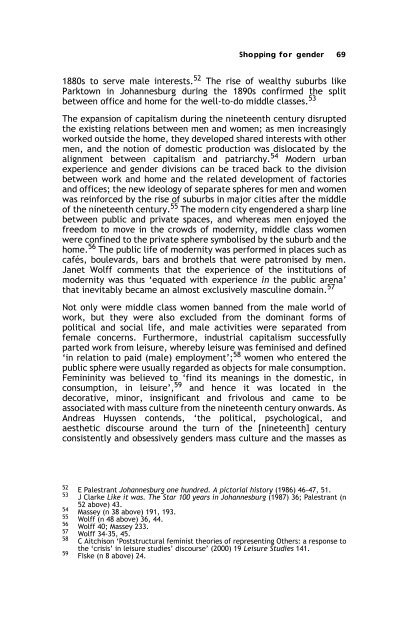Sex, Gender, Becoming - PULP
Sex, Gender, Becoming - PULP
Sex, Gender, Becoming - PULP
Create successful ePaper yourself
Turn your PDF publications into a flip-book with our unique Google optimized e-Paper software.
Shopping for gender 69<br />
1880s to serve male interests. 52 The rise of wealthy suburbs like<br />
Parktown in Johannesburg during the 1890s confirmed the split<br />
between office and home for the well-to-do middle classes. 53<br />
The expansion of capitalism during the nineteenth century disrupted<br />
the existing relations between men and women; as men increasingly<br />
worked outside the home, they developed shared interests with other<br />
men, and the notion of domestic production was dislocated by the<br />
alignment between capitalism and patriarchy. 54 Modern urban<br />
experience and gender divisions can be traced back to the division<br />
between work and home and the related development of factories<br />
and offices; the new ideology of separate spheres for men and women<br />
was reinforced by the rise of suburbs in major cities after the middle<br />
of the nineteenth century. 55 The modern city engendered a sharp line<br />
between public and private spaces, and whereas men enjoyed the<br />
freedom to move in the crowds of modernity, middle class women<br />
were confined to the private sphere symbolised by the suburb and the<br />
home. 56 The public life of modernity was performed in places such as<br />
cafés, boulevards, bars and brothels that were patronised by men.<br />
Janet Wolff comments that the experience of the institutions of<br />
modernity was thus ‘equated with experience in the public arena’<br />
that inevitably became an almost exclusively masculine domain. 57<br />
Not only were middle class women banned from the male world of<br />
work, but they were also excluded from the dominant forms of<br />
political and social life, and male activities were separated from<br />
female concerns. Furthermore, industrial capitalism successfully<br />
parted work from leisure, whereby leisure was feminised and defined<br />
‘in relation to paid (male) employment’; 58 women who entered the<br />
public sphere were usually regarded as objects for male consumption.<br />
Femininity was believed to ‘find its meanings in the domestic, in<br />
consumption, in leisure’, 59 and hence it was located in the<br />
decorative, minor, insignificant and frivolous and came to be<br />
associated with mass culture from the nineteenth century onwards. As<br />
Andreas Huyssen contends, ‘the political, psychological, and<br />
aesthetic discourse around the turn of the [nineteenth] century<br />
consistently and obsessively genders mass culture and the masses as<br />
52 E Palestrant Johannesburg one hundred. A pictorial history (1986) 46-47, 51.<br />
53 J Clarke Like it was. The Star 100 years in Johannesburg (1987) 36; Palestrant (n<br />
52 above) 43.<br />
54 Massey (n 38 above) 191, 193.<br />
55 Wolff (n 48 above) 36, 44.<br />
56<br />
Wolff 40; Massey 233.<br />
57 Wolff 34-35, 45.<br />
58 C Aitchison ‘Poststructural feminist theories of representing Others: a response to<br />
the ‘crisis’ in leisure studies’ discourse’ (2000) 19 Leisure Studies 141.<br />
59 Fiske (n 8 above) 24.
















